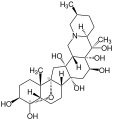
Steroidal alkaloids have the basic steroidal skeleton with nitrogen-based functional groups attached to the skeleton. More specifically, they are distinguished by their tetracyclic cyclopentanoperhydrophenanthrene skeleton that marks their close relationship with sterols. They fall in two major categories: Solanum alkaloids and Veratrum alkaloids. A Steroidal alkaloid has also been found in Chonemorpha fragrans (Frangipani vine), 'chonemorphine' was used to treat intestinal infections in Wistar rats. (Chatterjee DK et al (1987) Parasitol Res 74, 1, 30-33).
Examples
Apocynaceae steroid alkaloids
The family of apocynaceae alkaloids can be categorized based on their backbone structure, which may include the 5α-pregnane, Δ-pregnane, or conanine backbone. Typically, these alkaloids feature an amino group or an oxygen compound at the 3rd carbon atom. An illustrative example is latifolinin, which is derived from the conanine backbone. This distinctive structure is characterized by a five-membered ring formed by an amino group bonded to both the 18th and 20th carbon atoms.
Latifolinin is a compound that is naturally present in the bark of Funtumia latifolia. Additionally, the leaves of this plant contain two other compounds, namely funtumin and funtumidin. These compounds belong to the Apocynaceae steroid alkaloids family and share the 5α-pregnan backbone structure.
-
 Latifolinin
Latifolinin
-
![Funtumia africana (heterosynonym: Funtumia latifolia)]]](https://upload.wikimedia.org/wikipedia/commons/thumb/a/a7/Funtumia_africana-1906.jpg/85px-Funtumia_africana-1906.jpg) Funtumia africana (heterosynonym: Funtumia latifolia)]]
Funtumia africana (heterosynonym: Funtumia latifolia)]]
Batrachotoxins
Batrachotoxins are neurotoxins that are naturally occurring on the dermal surface of poison dart frogs. The photo shows the Phyllobates terribilis. Batrachotoxins share a structural foundation with pregnanes, consisting of 21 carbon atoms, and are distinctive for the amino group attached to the 18th carbon atom, exemplified by batrachotoxin A (see image).
Bufotoxins
The bufotoxins are named after the genus of Bufo. The α-pyranones at the 17th carbon atom are specific for the bufotoxins. The bufotoxin shown here is a sterane derivative with an α-pyranone at the 17th carbon atom and an esterified succinic acid at the 3rd carbon atom with arginine attached.
Buxus steroid alkaloids
Buxus steroid alkaloids are present in the leaves of the common boxwood (Buxus sempervirens). This plant primarily thrives in southern and central Europe. These alkaloids are characterized by an amino group attached to the 3rd and/or 20th carbon atom. Methylation of the amino groups can be partial, complete, or absent. Buxus steroid alkaloids constitute a substantial group of bases, most of which can be categorized into three distinct groups.
Another subgroup of Buxus steroid alkaloids possesses a tetracyclic structure. In these compounds, a bond exists between the 9th and 19th carbon atoms, forming a seven-membered ring (ring B). Buxamine E serves as an example of this group.
The third major group is distinguished by the absence of additional carbon atoms bonded to the 4th carbon atom of the A ring. Buxandonin L is an illustrative member of this category.
The largest group consists of pentacyclic Buxus steroid alkaloids, featuring a core structure based on 4,4,14-trimethyl-9,19-cyclopregnan. Cyclobuxin D is a representative of this particular group.
The Buxus steroid alkaloids buxamine E, buxandoline L, and cyclobuxin D are found in the leaves of common boxwood (buxus sempervirens).
-
 Buxamine E
Buxamine E
-
 Buxandonin L
Buxandonin L
-
 Cyclobuxin D
Cyclobuxin D
-
 Common boxwood (Buxus sempervirens)
Common boxwood (Buxus sempervirens)
Salamander alkaloids
The toxic salamander alkaloids occur naturally in organisms classified within the genus Salamandra. These alkaloids are derived from 3-aza-A-homo-5β-androstane. One notable example is samandarin (see figure), which may serve as the primary alkaloid depending on the species, although it may not be present in some other organisms at all. Samandarin possesses a distinctive oxazolidine structure within the A ring. Besides samandarin, there are several other steroid alkaloids in Salamandra organisms such as samandaridin, samandarone, and cycloneosamandione.
-
 Samandarin
Samandarin
-
 Salamander alkaloids, such as samandarin, occur on the skin of animals of the genus Salamandra.
Salamander alkaloids, such as samandarin, occur on the skin of animals of the genus Salamandra.
Solanum alkaloids
These compounds generally appear as their corresponding glycoside in plants of the genus Solanum. Solanum includes plants like potatoes, tomatoes, and various nightshades Starting with cholesterol, the biosynthesis of these compounds follow a similar general mechanism including hydroxylation, oxidation, and transamination before differentiating. Alkaloids found in these plants include chaconine, solanine, solasodine, tomatidine, tomatine, and solanidine. The Itkin group has found several of the biosynthetic gene clusters for these. In Itkin et al. 2011 and Itkin et al. 2013 they find several BSGs for α-tomatine in tomato and α-solanine in potato. Typically they are used in plants as a protection mechanism against animals. Due to the typical anti-cholinesterase activity, they can be used as poisons against the plants' predators. They can be used as starting materials for steroidal drugs. There are various tests for identifying these alkaloids. The characteristic test involves dissolving the compound in hot amyl alcohol or ethanol and watching for the formation of a jelly-like product as the mixture cools.
Solanidan skeleton
Steroidal alkaloids with a solanidan backbone exhibit a distinctive bicyclic structure, which replaces the cholesterol side chain on the D-ring. A notable example is solanocapsin, as discovered in the coral shrub (Solanum pseudocapsicum).
-
 Solanocapsin
Solanocapsin
-
 Solanocapsin is found, among other things, in the fruits of the Jerusalem cherry (Solanum pseudocapsicum).
Solanocapsin is found, among other things, in the fruits of the Jerusalem cherry (Solanum pseudocapsicum).
Spirosolan backbone
Another category of solanum alkaloids is based on the spirosolane skeleton. In these compounds, the E-ring is a tetrahydrofuran to which a piperidine is directly attached via a spiro compound. An example of such a steroid alkaloid is tomatidenol, which is prevalent across various species within the genus Solanum.
-
 Tomatidenol
Tomatidenol
-
Tomatidenol is found, among other things, in the leaves of the bittersweet nightshade (Solanum dulcamara). This plant species belongs to the nightshade genus. Tomatidenol forms the main alkamin in the species of Solanum dulcarama, which are native to Europe.
Veratrum alkaloids
Veratrum alkaloids of white/green chervil
The veratrum alkaloids derive their name from the white and green germer plants (Veratrum album and Veratrum viride, respectively). These plants belong to the Liliaceae family. Among them, procevin is a special case, as it features a nitrogen atom from piperidine connected to the 18th carbon.
Veratramine is an example of veratrum steroid alkaloids, characterized by a 22,26-epimino-14-abeo-cholestane ring system as their basis.
-
 Procevin
Procevin
-
 Veratramin
Veratramin
-
 Procevin and veratramin occur, among other things, in white veratrum (Veratrum album grandiflorum).
Procevin and veratramin occur, among other things, in white veratrum (Veratrum album grandiflorum).
Veratrum alkaloids of sabadill
Veracevin is a member of the veratrum alkaloids group. However, this occurs in the sabadilla (Schoenocaulon officinale), which also belongs to the Liliaceae family. The veracevin is based on the cevan skeleton, in which the C-ring is a five-membered instead of a six-membered ring and the D-ring is a six-membered ring. Furthermore, the high number of hydroxy groups is still remarkable.
-
 Veracevin
Veracevin
-
 Veracevin occurs in the Sabadilla (Schoenocaulon officinale).
Veracevin occurs in the Sabadilla (Schoenocaulon officinale).
Veratrum alkaloids
True to their name, Veratrum alkaloids come from plants of the genus Veratrum. Alkaloids are found in the roots and rhizomes of these plants. They include veratridine, cyclopamine, and jervine. Because of their actions on the cardiovascular, neuromuscular, and respiratory systems, Veratrum alkaloids have been used for the treatment of various conditions like myasthenia gravis, hypotension, and eclampsia.
Bioactivity
Steroidal alkaloids have been investigated for a wide range of potential bioactivities including antimicrobial, anti-inflammatory, anti-estrogenic, and chemotherapeutic activity. These bioactivities are the result of a wide array of mechanisms across different compounds. For example, solasodine antimicrobial bioactivity is accomplished by interfering with the synthesis of genetic substances in Saccharomyces cerevisiae and Prototheca wickerhamii. Solasodine inhibits growth signaling in Geim original algal. On the other hand, tomatidine synergistically works with aminoglycosides as antibiotics against S. aureus.
Antiinflammation is similarly accomplished with a variety of mechanisms. Solasodine, for example, reduces interleukin-2 and -8 production whereas tomatidine inhibits specific nuclear translocation, JNK activation, as well as induce nitrous oxide synthase. Lastly, nine steroidal alkaloids have significant antiestrogenic activity whereas seven inhibit estrone sulfatase.
However, in addition to their therapeutic benefits, steroidal alkaloids, specifically veratrum alkaloids, are potentially deadly.
Veratrum alkaloid compounds act by attaching to voltage-gated sodium ion channels, altering their permeability. Veratrum alkaloids cause affected sodium channels to reactivate 1000x slower than unaffected channels. Furthermore, veratrum alkaloids block inactivation of sodium channels and lower their activation threshold so they remain open even at resting potential. As a result, sodium concentrations within the cell rise, leading to increased nerve and muscle excitability. These biochemical channels cause muscle contractions, repetitive firing of the nerves and an irregular heart rhythm caused by stimulation of vagal nerves which control the parasympathetic functions of the heart, lungs and digestive tract.
References
- ^ "Steroidal Alkaloids". Pharmacognosy. July 2012. Retrieved 2018-05-05.
- Wiart Christophe Medicinal Plants Of The Asia-pacific: Drugs For The Future (2006), p. 454, at Google Books
- ^ Dictionary of steroids, London: Chapman & Hall, 1991, pp. XXV–XXVI, ISBN 0412270609
- ^ R. Hegnauer (1964), Chemotaxonomie der Pflanzen: Eine Übersicht über die Verbreitung und die systematische Bedeutung der Pflanzenstoffe, vol. 3, Basel: Springer Basel AG, pp. 127–129, doi:10.1007/978-3-0348-9385-5, ISBN 978-3-0348-9386-2
- Burkhard Fugmann, ed. (1997), "Apocynaceen-Steroidalkaloide", Römpp Lexikon Naturstoffe, vol. 1 (10 ed.), Stuttgart: Georg Thieme Verlag, p. 50, ISBN 978-3-131-99961-0
- Dictionary of steroids, London: Chapman & Hall, 1991, p. 644, ISBN 0412270609
- ^ Wolfgang Bücherl, Eleanor E. Buckley, eds. (1971), Venomous Animals and Their Venoms, vol. 2, New York: Academid Press, p. 261, doi:10.1016/C2013-0-10436-9, ISBN 978-0-12-138902-4
- Dictionary of steroids, London: Chapman & Hall, 1991, p. 86, ISBN 0412270609
- O. Gessner, G. Barger (1938), W. Heubner, J. Schüller (ed.), Handbuch der experimentellen Pharmakologie, vol. 6, Berlin: Springer-Verlag Berlin Heidelberg, p. 45, doi:10.1007/978-3-662-32921-4, ISBN 978-3-662-32094-5
- Yoshiaki Kamano, Hiroshi Yamamoto, Yoshihiro Tanaka, Manki Komatsu (1968), "The Isolation and Structure of new Bufadienolides, 3-(Hydrogen suberates) of Resibufogenin, Cinobufagin and Bufalin – the Structure of the so-called "Bufotoxins"", Tetrahedron Letters, vol. 9, no. 54, pp. 5673–5676, doi:10.1016/S0040-4039(00)70748-9, PMID 5748700
- Kazutake Shimada, Kazuo Ohishi, Hiroko Fukunaga, Jai Seup Ro, Toshio Nambara (1985), "Structure-activity relationship of bufotoxins and related compounds for the inhibition of Na+, K+ -adenosine triphosphatase", Journal of Pharmacobio-Dynamics, vol. 8, no. 12, pp. 1054–1059, doi:10.1248/bpb1978.8.1054, PMID 3009774
- Wolfgang Bücherl, Eleanor E. Buckley, eds. (1971), Venomous Animals and Their Venoms, vol. 2, New York: Academid Press, p. 546, doi:10.1016/C2013-0-10436-9, ISBN 978-0-12-138902-4
- ^ P. H. List, L. Hörhammer, ed. (1972), Hagers Handbuch der Pharmazeutischen Praxis: Chemikalien und Drogen (Am-Ch), vol. 3 (5 ed.), Berlin: Springer-Verlag Berlin Heidelberg GmbH, pp. 589–590, doi:10.1007/978-3-642-80562-2, ISBN 978-3-642-80563-9
- ^ Eberhard Breitmaier (2008), Alkaloide: Betäubungsmittel, Halluzinogene und andere Wirkstoffe, Leitstrukturen aus der Natur (3 ed.), Wiesbaden: Vieweg+Teubner – GWV Fachverlage GmbH, pp. 97–98, ISBN 978-3-8348-0531-7
- O. Gessner, G. Barger (1938), W. Heubner, J. Schüller (ed.), Handbuch der experimentellen Pharmakologie, vol. 6, Berlin: Springer-Verlag Berlin Heidelberg, p. 45, doi:10.1007/978-3-662-32921-4, ISBN 978-3-662-32094-5
- Entry on Salamander-Alkaloide. at: Römpp Online. Georg Thieme Verlag, retrieved {{{Datum}}}.Error in template * unknown parameter name (Template:RömppOnline): "Abruf"
- Atta-ur-Rahman, ed. (1995), Studies in Natural Products in Chemistry: Structure and Chemistry (Part C), vol. 15, Amsterdam: Elsevier, p. 337, ISBN 0-444-82083-3
- Dictionary of steroids, London: Chapman & Hall, 1991, p. 769, ISBN 0412270609
- T. Lüddecke, S. Schulz, S. Steinfartz (2018), "A salamander's toxic arsenal: review of skin poison diversity and function in true salamanders, genus Salamandra", The Science of Nature, vol. 105, no. 56, Springer Berlin Heidelberg, pp. 208–216, Bibcode:2018SciNa.105...56L, doi:10.1007/s00114-018-1579-4, PMID 30291447, S2CID 52924816
- ^ "Steroid Alkaloids". Cornell University Department of Animal Science. Retrieved 2018-05-05.
- Ohyama K, Okawa A, Moriuchi Y, Fujimoto Y (May 2013). "Biosynthesis of steroidal alkaloids in Solanaceae plants: involvement of an aldehyde intermediate during C-26 amination". Phytochemistry. 89 (17): 26–31. Bibcode:2013PChem..89...26O. doi:10.1016/j.phytochem.2013.01.010. PMID 23473422.
- ^ Lacchini E, Goossens A (2020-10-06). "Combinatorial Control of Plant Specialized Metabolism: Mechanisms, Functions, and Consequences". Annual Review of Cell and Developmental Biology. 36 (1). Annual Reviews: 291–313. doi:10.1146/annurev-cellbio-011620-031429. ISSN 1081-0706. PMID 32559387. S2CID 219947907.
- ^ Nützmann HW, Scazzocchio C, Osbourn A (2018-11-23). "Metabolic Gene Clusters in Eukaryotes". Annual Review of Genetics. 52 (1). Annual Reviews: 159–183. doi:10.1146/annurev-genet-120417-031237. ISSN 0066-4197. PMID 30183405. S2CID 52161448.
- ^ Eberhard Breitmaier (2008), Alkaloide: Betäubungsmittel, Halluzinogene und andere Wirkstoffe, Leitstrukturen aus der Natur (3 ed.), Wiesbaden: Vieweg+Teubner – GWV Fachverlage GmbH, p. 90, ISBN 978-3-8348-0531-7
- Dictionary of steroids, London: Chapman & Hall, 1991, p. 801, ISBN 0412270609
- Helmut Ripperger Klaus Schreiber (1969), "Solanum-Alkaloide, LXXXIX. Synthese des Steroidalkaloids Leptinidin und weiterer 23β-Hydroxy-solanidane", Chemische Berichte, vol. 102, no. 12, Weinheim: WILEY-VCH Verlag GmbH & Co., pp. 4080–4088, doi:10.1002/cber.19691021215, PMID 5367544
- Dictionary of steroids, London: Chapman & Hall, 1991, p. 858, ISBN 0412270609
- R. Hegnauer (1986), Chemotaxonomie der Pflanzen: Eine Übersicht über die Verbreitung und die systematische Bedeutung der Pflanzenstoffe, vol. 7, Basel: Springer Basel AG, p. 427, doi:10.1007/978-3-0348-9314-5, ISBN 978-3-0348-9991-8
- ^ Jakob Büchi (1963), Grundlagen der Arzneimittelforschung und der synthetischen Arzneimittel, Basel: Springer Basel AG, pp. 45–46, doi:10.1007/978-3-0348-4019-4, ISBN 978-3-0348-4020-0
- ^ Burkhard Fugmann, ed. (1997), "Veratrum–Steroidalkaloide", Römpp Lexikon Naturstoffe (10 ed.), Stuttgart: Georg Thieme Verlag, pp. 680–681, ISBN 978-3-132-00061-2
- Dictionary of steroids, London: Chapman & Hall, 1991, p. 759, ISBN 0412270609
- Dictionary of steroids, London: Chapman & Hall, 1991, p. 943, ISBN 0412270609
- R. Hegnauer (1986), Chemotaxonomie der Pflanzen: Eine Übersicht über die Verbreitung und die systematische Bedeutung der Pflanzenstoffe, vol. 7, Basel: Springer Basel AG, p. 711, doi:10.1007/978-3-0348-9314-5, ISBN 978-3-0348-9991-8
- Friedrich Constabel, Indra K. Vasil, eds. (1984), Cell Culture and Somatic Cell Genetics of Plants: Phytochemicals in Plant Cell Cultures, vol. 5, San Diego: Academic Press, p. 538, ISBN 0-12-715005-6
- ^ Hollman A (May 1991). "Veratrum alkaloids". British Heart Journal. 65 (5): 286. doi:10.1136/hrt.65.5.286. PMC 1024632. PMID 18610390.
- Dey P, Kundu A, Chakraborty HJ, Kar B, Choi WS, Lee BM, Bhakta T, Atanasov AG, Kim HS (2018). "Therapeutic value of steroidal alkaloids in cancer: Current trends and future perspectives". International Journal of Cancer. 145 (7): 1731–1744. doi:10.1002/ijc.31965. PMC 6767045. PMID 30387881.
- ^ Jiang QW, Chen MW, Cheng KJ, Yu PZ, Wei X, Shi Z (January 2016). "Therapeutic Potential of Steroidal Alkaloids in Cancer and Other Diseases". Medicinal Research Reviews. 36 (1): 119–43. doi:10.1002/med.21346. PMID 25820039. S2CID 206251649.
- ^ Furbee B (2009). "Neurotoxic plants". Clinical Neurotoxicology: Syndromes, Substances, Environments. Elsevier Inc.
- ^ Heilpern KL (February 1995). "Zigadenus poisoning". Annals of Emergency Medicine. 25 (2): 259–62. doi:10.1016/S0196-0644(95)70336-5. PMID 7832360.



